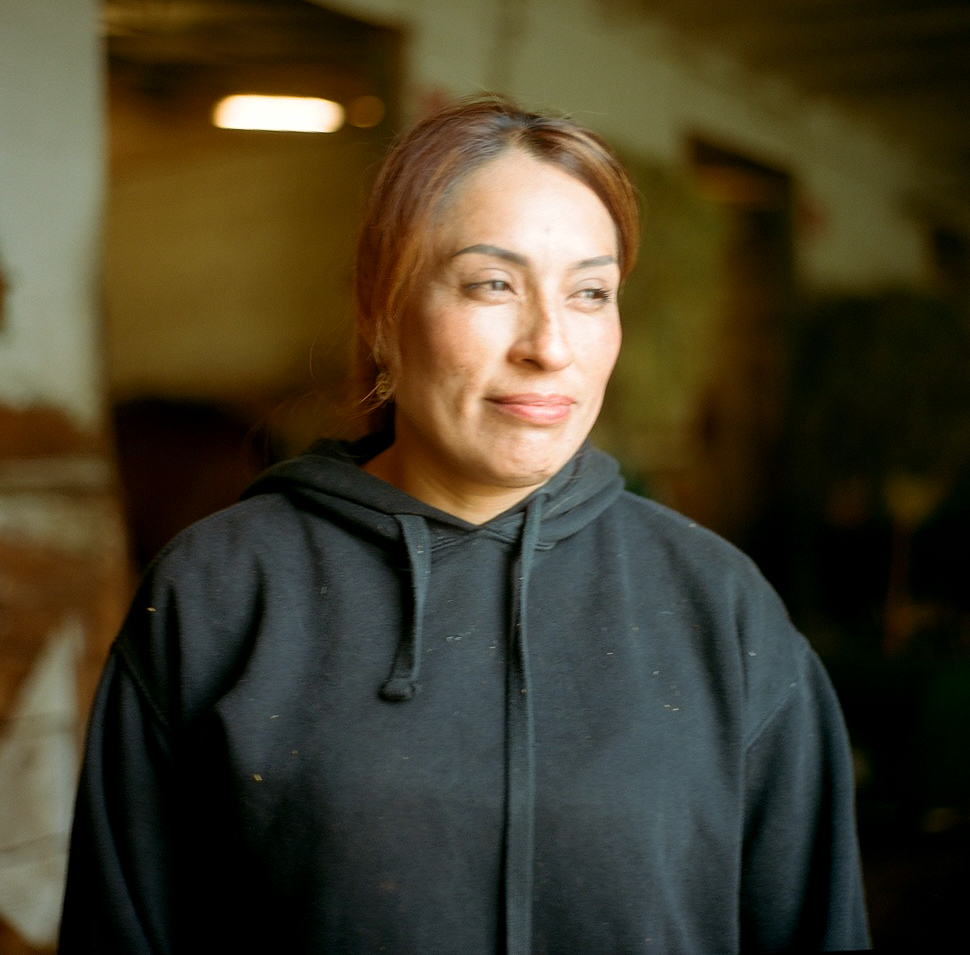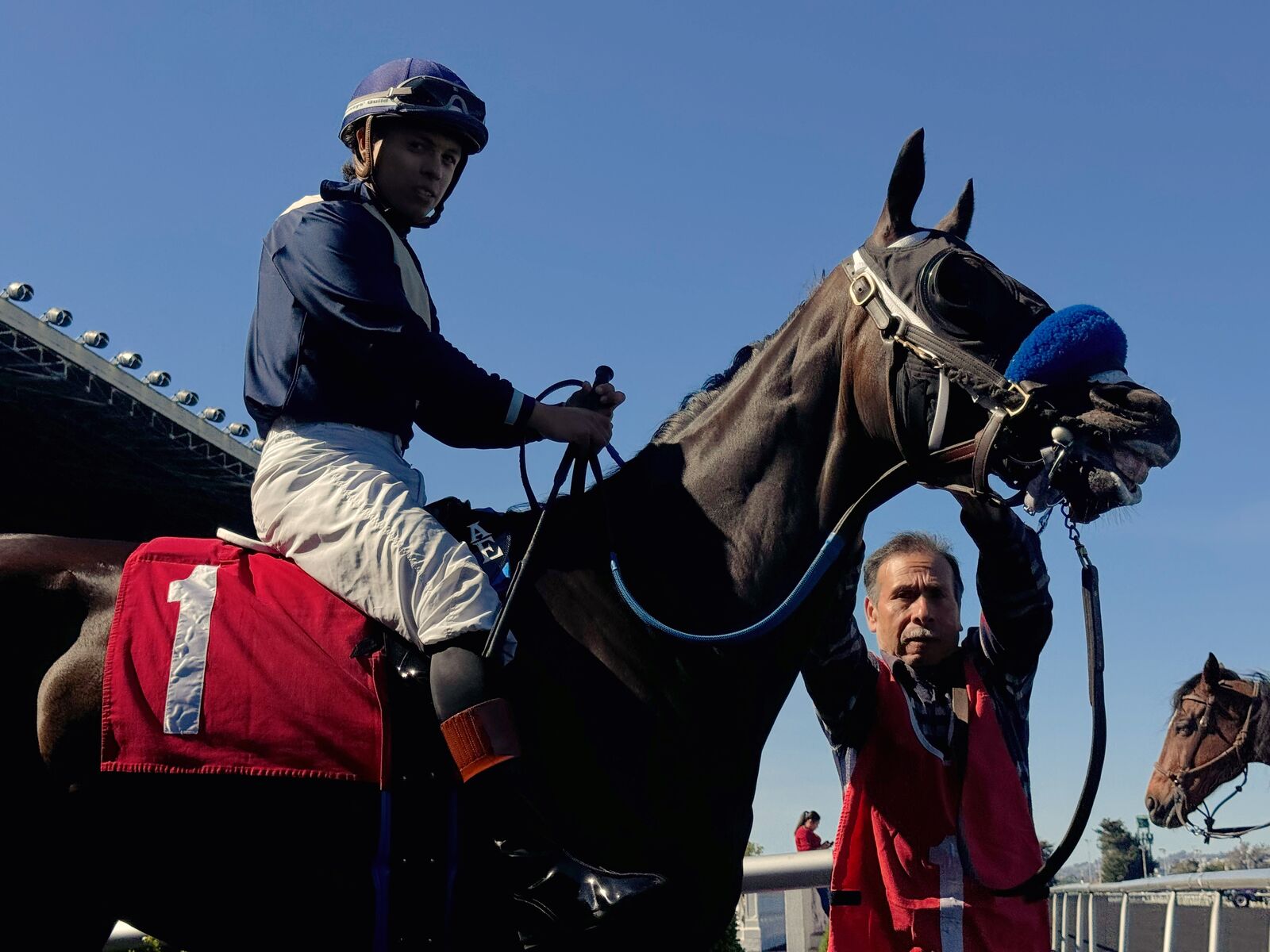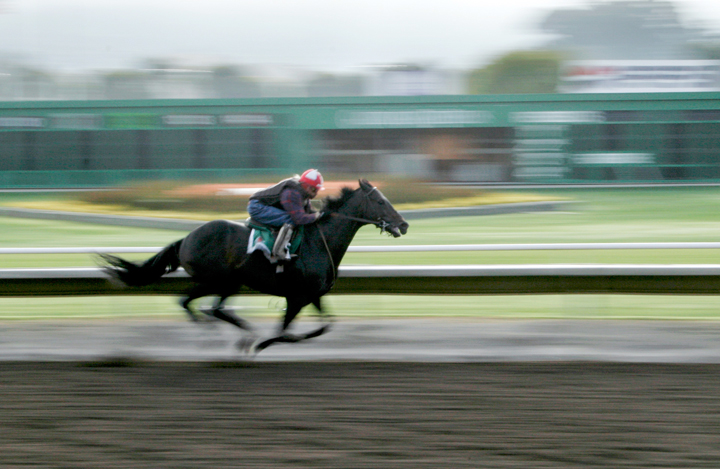Nicolas Hernandez has lived in Berkeley for about 17 years. He came to California for the horses, moved to the Bay Area for the horses and, soon after Golden Gate Fields holds its final races Sunday, Hernandez will leave with the horses.
GOLDEN GATE FIELDS: END OF AN ERA
This story, a peak into the simulcast room at the horse racing track, is the second of a three-part series on Golden Gate Fields. Part 1 looks at the 90-year history of the track. Part 3 reports on the uncertain future for the hundreds of employees who lived on site in the “backstretch.”
Like most of the 200-plus workers who live in a barn area of Golden Gate Fields, known as the “backstretch” of a race track, Hernandez is an immigrant. The horse groom from rural Mexico lives with his wife in a tack room, which is meant to store racing equipment but is commonly used for grooms to remain with the horses overnight.
Hernandez rarely leaves his track community, mostly just to buy groceries or go to the bank. He wakes at 4 a.m. to feed the horses, works through the early afternoon, maybe rides his bicycle in the evening and falls asleep each night around 8.
“Even I wonder, when I see that 20 years have passed, I say, what have I done? Where have I been?” Hernandez asked aloud on a recent Tuesday morning at the track. In a nearby room, his wife, Francisca, watched the children of other backstretch workers.

You can imagine the anxiety for this workforce, which is 98% immigrant Latino — from Mexico, Central and South America.
Oscar de la Torre
Golden Gate Fields is the only full-time track in Northern California, and its closure threatens the livelihoods of the industry’s most-vulnerable workers, many of whom cling to the hope that a proposed fall racing meet in Pleasanton will provide housing and work.
Leslie Berkler, executive director of the Women’s Daytime Drop-In Center in Berkeley, about 2 miles from the track, said she has connected with 10 families who work on the backstretch, nine who have children. The families are unsure about housing plans in Pleasanton, and were referred to the drop-in center by family counselors with Berkeley Unified School District. Some families hadn’t been told whether their trainers would be taking horses to Pleasanton, Berkler said.
“We want to prevent any families from becoming unhoused in Berkeley,” she said.
Berkler, who fears she won’t know the total impact on families until after the closure, is working with the city’s department of Health, Housing and Community Services.
“You can imagine the anxiety for this workforce, which is 98% immigrant Latino — from Mexico, Central and South America,” said Oscar de la Torre, who the California Horse Racing Board has hired on a temporary basis to assist the workers. Backstretch workers are not unionized and often work on temporary visas. “They don’t have the type of voice that other workers have within the industry,” de la Torre said.


Workers living on the Golden Gate Fields backstretch don’t pay rent. They sleep inside tack rooms that are attached to rows of barns and sheds between Interstate 580 and the San Francisco Bay shoreline. Other backstretch workers, such as exercise riders, who gallop horses in the morning; hotwalkers, who cool down the horses; and foremen and forewomen, who supervise the staff of horse trainers, live in nearby communities.
The Golden Gate Fields backstretch is beyond the south fence of the track, on the Berkeley portion of the 130-acre property (the track, grandstands and track offices are in Albany). Backstretch workers are paid by trainers — a track steward report on the state board website reveals one groom making $100 per day. The number of workers living at the track was reported as 370 in 2020 by Berkeleyside, when more than 200 track employees were infected in a coronavirus outbreak, both those who live at the track and those who only work there. Last July, the San Francisco Chronicle reported more than 300 workers lived at the track, watching over nearly 1,000 horses.
The workers share bathrooms, a cafeteria and recreation center. Hernandez uses an electric stove to cook outside. The California Thoroughbred Horsemen Foundation provides health and dental facilities. Another group, the Winners Foundation, assists workers who battle drug and alcohol addiction. Many families confide in Rob Cochran, the track chaplain.
It’s a big backbone of the industry.
Isidro Tamayo
“It’s a big backbone of the industry,” said trainer Isidro Tamayo, who lives in Pinole, of the backstretch workers. “Most of them have families and kids who go to school near the race track. Moving to Pleasanton will affect their livelihoods because they will have to change schools. They won’t see their friends. It’s causing a lot of pain, not only financially but also personally.”
Josefa Benitez has worked on the Golden Gate Fields backstretch for more than a decade. But she won’t be moving to Pleasanton, or any other track.
Benitez is the only forewoman on the backstretch, she says. The rest are foremen. Benitez’s boss, a horse trainer, is leaving Northern California. But Benitez will stay in Richmond and work as a caretaker. She shares an apartment with her 15-year-old son, a promising student. Her daughter is an economics major at UC Santa Barbara.

Like many backstretch workers at Golden Gate Fields, Benitez was raised in a rural part of the central Mexican state of Zacatecas. Benitez’s brother-in-law helped both her and her husband find work at the East Bay track, and the couple chose to pay for a Richmond apartment rather than live for free in a tack room on the backstretch.
“We did it for the sake of our children, even if it was a very small place and we were barely making ends meet,” said Benitez, who is now divorced, of the apartment. “We wanted them to have their own space, and a bathroom, not to worry about them roaming among the horses.”
Berkeleyside reporters visited the Golden Gate Fields backstretch on three occasions this spring. On a 10-minute walk through the barn area during a Saturday meet in April, workers could be seen feeding oats to horses sticking their heads out of stalls. Some of the massive thoroughbreds were being washed after races, while others circled a motorized walker.
A row of Jarritos soda and water bottles lined the window sill of a tack room. Garments hung from a clothesline near a weather-beaten washing machine. Above, a track sign facing Interstate 580 read “WHERE THE BAY COMES TO PLAY.”
Low pay and few protections

The “Terms and Conditions of Stabling and Racing” on the Golden Gate Fields website outline the agreement between the track operators, horse trainers and backstretch workers. The terms mostly absolve the Pacific Racing Association — which operates the track for its owners, the Stronach Group — of responsibility for the backstretch.
“PRA has no obligation to remedy any condition on the premises which may be caused by the negligence of, or willful conduct of, any such employees, agents, or invitees, unless it has prior written notice of the existence of such condition and has had a reasonable opportunity to repair such condition,” the 2024 stall application states.
The application says trainers must “properly supervise all of their employees, agents, invitees, and other persons known to them.” Trainers are required to hire “competent personnel to take care of (horses) at all times, cleaning and maintaining stalls” and “removing any hazardous condition from such stalls.”
The California Horse Racing Board rulebook, found on its website, says that backstretch housing must be inspected at least once per year. The inspections are to be conducted by a board representative “with assistance from the California Department of Housing and Community Development or a local housing authority.” The race track is required to provide “habitable rooms” that include natural light, ventilation, at least one electric light and at least 50 feet of square space with no less than 7 feet in any direction.


The Stronach Group did not respond to multiple interview requests. An employee whose phone number was listed on the company’s “notice of mass layoff” issued April 5 gave a “no comment” when asked about Golden Gate Fields employees. She referred Berkeleyside to a media relations employee, who has not responded to an email seeking an interview.
In April, when Berkeleyside asked Golden Gate Fields about attending a Saturday meet, an employee suggested by phone that we attend a different date and said “professional cameras” were not allowed at the track. When told of the track policy, a state board member said the Stronach Group was “scared of their own shadow.”
The Stronach Group will now consolidate its state racing to Santa Anita Park in Arcadia.
That level of secrecy could result from a 2019 horse doping scandal that followed dozens of horse fatalities at the group’s Southern California track, Santa Anita Park. The deaths led to what de la Torre called a “full-on assault by the media” on the racing industry. Dr. Greg Ferraro, a longtime director of the UC Davis Center for Equine Health, was appointed chair of the state board by Gov. Gavin Newsom.
The Stronach Group will now consolidate its state racing to Santa Anita Park in Arcadia. The group recently sold Pimlico Race Course, the Baltimore home of a triple-crown race, the Preakness Stakes, to the state of Maryland. The Stronach Group, which is chaired by Belinda Stronach, a former member of the Canadian parliament, has also been in talks about being the primary investor in a Major League Soccer team in Sacramento.
Ferraro learned of the Golden Gate Fields closure last summer when he was informed that the state was negotiating to purchase the property, he told Thoroughbred Daily News. An Albany spokesperson wrote to Berkeleyside in April that the city “continues to work with all interested parties regarding the transition of the property.” A Berkeley spokesperson wrote in May there have been “informal discussions” about the land.
Golden Gate Fields is not alone. According to horseracingwrongs.com, 45 tracks have closed across the nation since 2000, including Bay Meadows in San Mateo in 2008, which left Golden Gate Fields as the last full-time track in Northern California. Alameda County Fairgrounds in Pleasanton has applied to replace Golden Gate Fields as the hub of Northern California racing, and has proposed to house the families of backstretch workers in residential vehicles rather than tack rooms.

In March, the Stronach Group urged the state board to deny 26 dates to Pleasanton, writing in a letter that the current model of racing in California is “simply unsustainable.” Many trainers and breeders believe Northern California racing won’t survive without a full-time track. And its demise could be a boon for Southern California if more trainers take their horses south and create bigger and more competitive racing fields with larger purses. But industry insiders say most horses who race at Golden Gate Fields wouldn’t be able to compete against higher-level competition at the Southern California tracks.
The board unanimously granted the dates to Pleasanton, but still must approve the race application. Larry Swartzlander, executive director of the California Authority of Racing Fairs, would operate the Pleasanton meet under Golden State Racing branding. The Pleasanton race track, built in 1858, is one of the oldest in the nation and already holds a summer fair meet in June and July. Swartzlander hopes to attract crowds of 2,500-3,000 fans for the longer fall meet.
De la Torre called the plan a “lifeline” to backstretch workers.
A matter of ‘social justice’

The Santa Monica council member said 62 backstretch workers attended a town hall at the Golden Gate Fields recreation center in April. He also holds weekly Zoom meetings. De la Torre calls his advocacy for the workers an issue of “racial, economic and social justice.” He says their main concerns are housing security, enrolling their children in new schools and knowing which trainers are taking horses to the Pleasanton meet. A smaller number of horses are expected to move to the Cal Expo race track in Sacramento. Horses must leave Golden Gate Fields stalls by June 19, the track’s April layoff notice stated.
However, bloodhorse.com, a horse racing industry publication, reported Wednesday that Golden Gate Fields would keep open its equine hospital, perhaps delaying the closure of the track’s entire backstretch. “Perimeter security will be required to discourage squatters. Water and power must be continued for fire prevention and safety,” the website reported, referring to “track management” as their source.
The living conditions (in Pleasanton), I think, would be an improvement to the tack rooms at Golden Gate Fields.
Oscar de la Torre
Swartzlander expects 60-70 trainers to bring horses to Alameda County Fairgrounds, creating jobs for 350-400 backstretch workers, he wrote in an email to Berkeleyside. Swartzlander and de la Torre told Berkeleyside in separate interviews that Pleasanton has approximately 40 spaces for residential vehicles. They would be sold to workers at “reduced rates,” Swartzlander said. The housing plan presented by Swartzlander to the state board in March stated that 150 residential vehicle spots are in inventory at Pleasanton, and that “rental and purchases are the responsibility of the trainer/owner.”
Swartzlander said families of backstretch workers would not be allowed to live in tack rooms, which he said are for racing personnel only.

“The living conditions (in Pleasanton), I think, would be an improvement to the tack rooms at Golden Gate Fields,” de la Torre said. “Knowing you’re going to close something, there isn’t a high level of investment.”
The Stronach Group issued a “mass layoff” notice to the Alameda County Workforce Development Board in April, as required in the termination of 75 or more workers. The notice for 201 employees, many of whom are represented by unions (including janitors, carpenters, bartenders and one track announcer), didn’t include backstretch workers, however, because they work for independent horse trainers.
The office for Berkeley councilmember Rashi Kesarwani, whose District 1 includes the Golden Gate Fields backstretch, directed Berkeleyside to the Office of Economic Development when asked to speak in late April about the track closure and its workers. The Office of Economic Development forwarded questions to a city spokesperson. When asked how Berkeley is assisting track employees, the spokesperson replied in an email that “you’d have to talk to the operators of the facility. They are the employer.”
(Note: Berkeleyside later learned that the Women’s Daytime Drop-in Center, which receives funding from Berkeley, is working with the city’s Health, Housing and Community Services department. After this story was published, the city spokesperson told Berkeleyside in an email that city staff was working with the state racing board and Berkeley Unified School District to direct families to available resources.)


Kesarwani was not available for comment when her office was again contacted Wednesday and Thursday. In a statement following the track’s announced closure in July, Berkeley Mayor Jesse Arreguín wrote that the “priority right now must be on ensuring that workers are made whole and supported and that the horses are given proper care and relocation during the closure.”
Former Councilmember Kate Harrison, during a July phone interview with Berkeleyside, addressed “low-wage workers” at the race track. “The job situation is a concern,” she said. “I would look forward to them being retrained and finding jobs that are safer.”
Last June, Harrison proposed an ordinance to establish a “race horse protection policy” that would limit the hours that horses could stay in stalls. Harrison has since resigned from the City Council and is now running for mayor. Golden Gate Fields, which has a synthetic and turf track, has had six horse deaths through May 11 of this year, according to data on the state racing board website.
At the end of the day, we are a family and we will fight it out and try to survive.
Isidro Tamayo
The dirt race track at Alameda County Fairgrounds in Pleasanton had five horse deaths during its 2023 summer meet. This year’s Pleasanton summer meet will run from June 14 to July 7. The fair racing circuit then heads to Cal Expo in Sacramento, Ferndale and Fresno. Assuming the state board accepts Pleasanton’s fall meet proposal, the circuit would then return to Alameda County Fairgrounds from Oct. 16 through Dec. 25.
“At the end of the day, we are a family and we will fight it out and try to survive,” said Tamayo, whose horses have won 600 races and earned more than $10 million over the past eight years, according to his racing profile on equibase.com. “We can try our best to continue racing in NorCal and try to support it.
“You want to stay positive.”
Hernandez, the groom, says “there is nothing certain for anyone” about Pleasanton — similar to when he joined his uncles at a Southern California track in the early 1980s.

“I was 15,” recalls the oldest of 10 siblings from the village of Cerro Chino in Zacatecas. “It was different,” Hernandez said of working with race horses in California, compared to in Mexico, where horses are used more for agricultural work. “More sophisticated. We learned here, and we stayed here.”
When he arrived, there were few immigrants in stables. Now, they are the majority.
“I think it’s a job that doesn’t need school,” he explains. “From my experience, you just have to want to work and get ahead. I came for six months. The truth is, I do like what I do. So, no, no, I can’t imagine having done anything else.”




